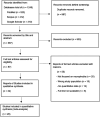Unveiling neurophobia: exploring factors influencing medical students, residents and non-neurologist physicians globally and its implications on neurology care - a systematic review and meta-analysis
- PMID: 40406367
- PMCID: PMC12096978
- DOI: 10.1136/bmjno-2024-001009
Unveiling neurophobia: exploring factors influencing medical students, residents and non-neurologist physicians globally and its implications on neurology care - a systematic review and meta-analysis
Abstract
Background: Neurophobia, the fear of neurology, is a recognised global challenge in medical education and practice. This systematic review and meta-analysis aimed to quantify the prevalence of neurophobia among medical students, residents and non-neurologist physicians, identify contributing factors (including lack of basic science/clinical integration) and explore its implications for neurology care.
Methods: We systematically searched PubMed, Scopus and Google Scholar for studies published between 2000 and 2024 reporting on neurophobia. Two independent reviewers screened the studies, extracted data and assessed their quality using the Newcastle-Ottawa Scale. A random effects meta-analysis was performed to estimate the pooled prevalence of neurophobia. Heterogeneity and publication bias were tested statistically.
Results: Of the initial 1245 studies, 32 met the inclusion criteria. The pooled prevalence of neurophobia was 47.2% (95% CI: 39.8% to 54.6%), with significant heterogeneity (I²=98.7%, p<0.001). Subgroup analysis revealed a higher prevalence among medical students (52.3%, 95% CI: 44.1% to 60.5%) than residents and physicians (41.9%, 95% CI: 33.7% to 50.1%). Key contributing factors included the perceived complexity of neurology (OR: 3.2, 95% CI: 2.7 to 3.8) and inadequate exposure during training (OR: 2.8, 95% CI: 2.3 to 3.3). Individuals with neurophobia were less likely to consider a career in neurology (OR 0.32, 95% CI: 0.25 to 0.41).
Conclusions: Neurophobia affects a substantial proportion of medical trainees and practitioners globally, with variation across education and practice levels. Addressing contributing factors through targeted interventions may help mitigate neurophobia and improve neurological care. Further studies should focus on specific interventions.
Keywords: CLINICAL NEUROLOGY; MEDICINE; META-ANALYSIS; NON-CLINICIAN; SYSTEMATIC REVIEWS.
Copyright © Author(s) (or their employer(s)) 2025. Re-use permitted under CC BY-NC. No commercial re-use. See rights and permissions. Published by BMJ Group.
Conflict of interest statement
No, there are no competing interests.
Figures


Similar articles
-
Prevalence of neurophobia among medical students and young doctors: a systematic review and meta-analysis.BMC Med Educ. 2024 Nov 9;24(1):1286. doi: 10.1186/s12909-024-06303-3. BMC Med Educ. 2024. PMID: 39522038 Free PMC article.
-
Neurophobia among medical students and resident trainees in a tertiary comprehensive hospital in China.BMC Med Educ. 2023 Nov 2;23(1):824. doi: 10.1186/s12909-023-04812-1. BMC Med Educ. 2023. PMID: 37919684 Free PMC article.
-
Neurophobia in medical students and junior doctors--blame the GIK.Ann Acad Med Singap. 2013 Nov;42(11):559-66. Ann Acad Med Singap. 2013. PMID: 24356651
-
Neurophobia and its Correlates among Undergraduate Clinical Students in a Nigerian Private University.Niger Med J. 2023 May 11;64(2):251-258. eCollection 2023 Mar-Apr. Niger Med J. 2023. PMID: 38898964 Free PMC article.
-
[Neurophobia].Ideggyogy Sz. 2012 Jul 30;65(7-8):221-8. Ideggyogy Sz. 2012. PMID: 23074841 Review. Hungarian.
References
-
- Flanagan E, Walsh C, Tubridy N. Neurophobia’attitudes of medical students and doctors towards neurology: a systematic review. Eur J Neurol. 2015;22:261–8. - PubMed
-
- Feigin VL, Vos T, Alahiri E, et al. Burden of neurological disorders across the world. Lancet Neurol. 2021;20:741–68.
LinkOut - more resources
Full Text Sources
Miscellaneous
